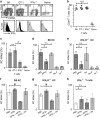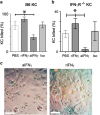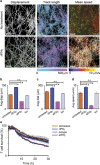Interferon-γ derived from cytotoxic lymphocytes directly enhances their motility and cytotoxicity
- PMID: 28569770
- PMCID: PMC5520949
- DOI: 10.1038/cddis.2017.67
Interferon-γ derived from cytotoxic lymphocytes directly enhances their motility and cytotoxicity
Abstract
Interferon gamma (IFNγ) is a key moderator of cell-mediated immunity with diverse, mainly pro-inflammatory actions on immunocytes and target tissue. Recent studies have shown it may enhance anti-tumor and antiviral effects of CD8 T cells. Here we investigate the mechanisms by which IFNγ mediates CD8 T-cell cytotoxic function. We show that in vivo, antigen-specific CD8 T cells that produce INFγ are necessary to effect rejection of skin grafts expressing OVA as a transgene in keratinocytes. The ability of CD8 T cells to produce IFNγ enhanced their ability to migrate to the site of antigen-presenting skin cells. By in vivo imaging, we show that CTL motility, particularly speed, during graft rejection was enhanced by locally available IFNγ. We then used a reductionist two-cell model of CTL effectors and keratinocyte targets to investigate the effects of locally available (paracrine) and CTL-producing (autocrine) IFNγ on the motility behavior and killing ability of the CTL. Using live-cell imaging by prolonged time-lapse microscopy of primary effector CD8 T cells and antigen-expressing primary keratinocyte targets, we show that CD8 T-cell cytotoxic function and motility is enhanced by locally available IFNγ. Conversely, deprivation of either autocrine or paracrine IFNγ, or blockade of IFNγ signaling to CTL markedly reduced their cytotoxic function, their kinematics, and effector cell survival. We conclude that in vitro and in vivo, autocrine production of IFNγ by CTL enhances their motility and promotes killing of primary target keratinocytes. The absolute need for local IFNγ to enable cytotoxic CD8 T-cell function is of significance for immunotherapy for chronic viral infection and for cancer.
Conflict of interest statement
The authors declare no conflict of interest.
Figures







Similar articles
-
Antigen-specific CD8 T cells can eliminate antigen-bearing keratinocytes with clonogenic potential via an IFN-gamma-dependent mechanism.J Invest Dermatol. 2010 Jul;130(7):1841-8. doi: 10.1038/jid.2010.49. Epub 2010 Mar 18. J Invest Dermatol. 2010. PMID: 20237491
-
Interleukin-4-mediated downregulation of cytotoxic T lymphocyte activity is associated with reduced proliferation of antigen-specific CD8+ T cells.Microbes Infect. 2003 Sep;5(11):923-32. doi: 10.1016/s1286-4579(03)00190-4. Microbes Infect. 2003. PMID: 12941383
-
The duration of TCR/pMHC interactions regulates CTL effector function and tumor-killing capacity.Eur J Immunol. 2009 Aug;39(8):2259-69. doi: 10.1002/eji.200939341. Eur J Immunol. 2009. PMID: 19637198
-
T cell-mediated help against tumors.Cell Cycle. 2008 Oct;7(19):2974-7. doi: 10.4161/cc.7.19.6798. Epub 2008 Oct 15. Cell Cycle. 2008. PMID: 18838866 Review.
-
Activation of CTL-specific genes during cell-mediated cytolysis in vivo: expression of the HF gene analyzed by in situ hybridization.Immunol Rev. 1988 Mar;103:73-85. doi: 10.1111/j.1600-065x.1988.tb00750.x. Immunol Rev. 1988. PMID: 3292397 Review. No abstract available.
Cited by
-
E-cigarette-induced pulmonary inflammation and dysregulated repair are mediated by nAChR α7 receptor: role of nAChR α7 in SARS-CoV-2 Covid-19 ACE2 receptor regulation.Respir Res. 2020 Jun 18;21(1):154. doi: 10.1186/s12931-020-01396-y. Respir Res. 2020. PMID: 32552811 Free PMC article.
-
Investigation of the Immune Modulatory Potential of Zinc Oxide Nanoparticles in Human Lymphocytes.Nanomaterials (Basel). 2021 Mar 3;11(3):629. doi: 10.3390/nano11030629. Nanomaterials (Basel). 2021. PMID: 33802496 Free PMC article.
-
Tissue-specific abundance of interferon-gamma drives regulatory T cells to restrain DC1-mediated priming of cytotoxic T cells against lung cancer.Immunity. 2023 Feb 14;56(2):386-405.e10. doi: 10.1016/j.immuni.2023.01.010. Epub 2023 Feb 2. Immunity. 2023. PMID: 36736322 Free PMC article.
-
Thymoquinone Effect on Monocyte-Derived Macrophages, Cell-Surface Molecule Expression, and Phagocytosis.Nutrients. 2022 Dec 8;14(24):5240. doi: 10.3390/nu14245240. Nutrients. 2022. PMID: 36558399 Free PMC article.
-
JAK-STAT Signaling: A Double-Edged Sword of Immune Regulation and Cancer Progression.Cancers (Basel). 2019 Dec 12;11(12):2002. doi: 10.3390/cancers11122002. Cancers (Basel). 2019. PMID: 31842362 Free PMC article. Review.
References
-
- Martinet L, Garrido I, Filleron T, Le Guellec S, Bellard E, Fournie JJ et al. Human solid tumors contain high endothelial venules: association with T- and B-lymphocyte infiltration and favorable prognosis in breast cancer. Cancer Res 2011; 71: 5678–5687. - PubMed
-
- Bellavance EC, Kohlhapp FJ, Zloza A, O'Sullivan JA, McCracken J, Jagoda MC et al. Development of tumor-infiltrating CD8+ T cell memory precursor effector cells and antimelanoma memory responses are the result of vaccination and TGF-β blockade during the perioperative period of tumor resection. J Immunol 2011; 186: 3309–3316. - PMC - PubMed
MeSH terms
Substances
LinkOut - more resources
Full Text Sources
Other Literature Sources
Research Materials

